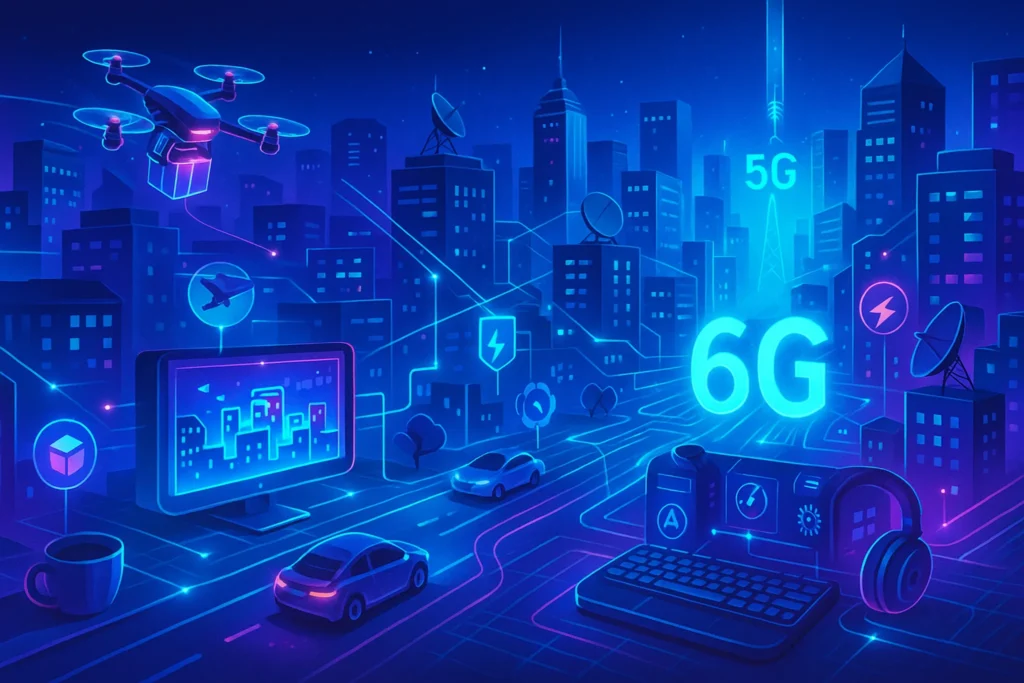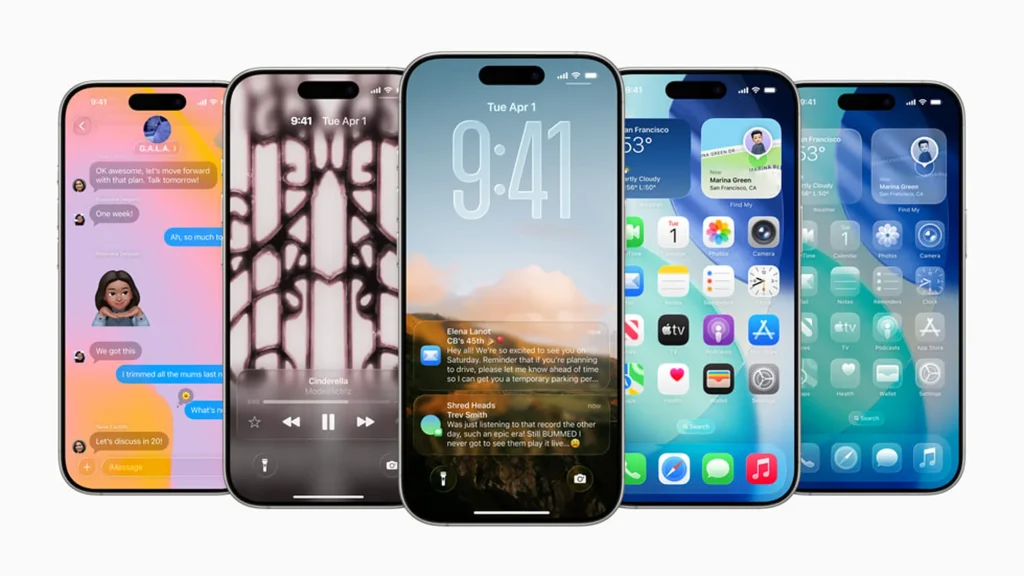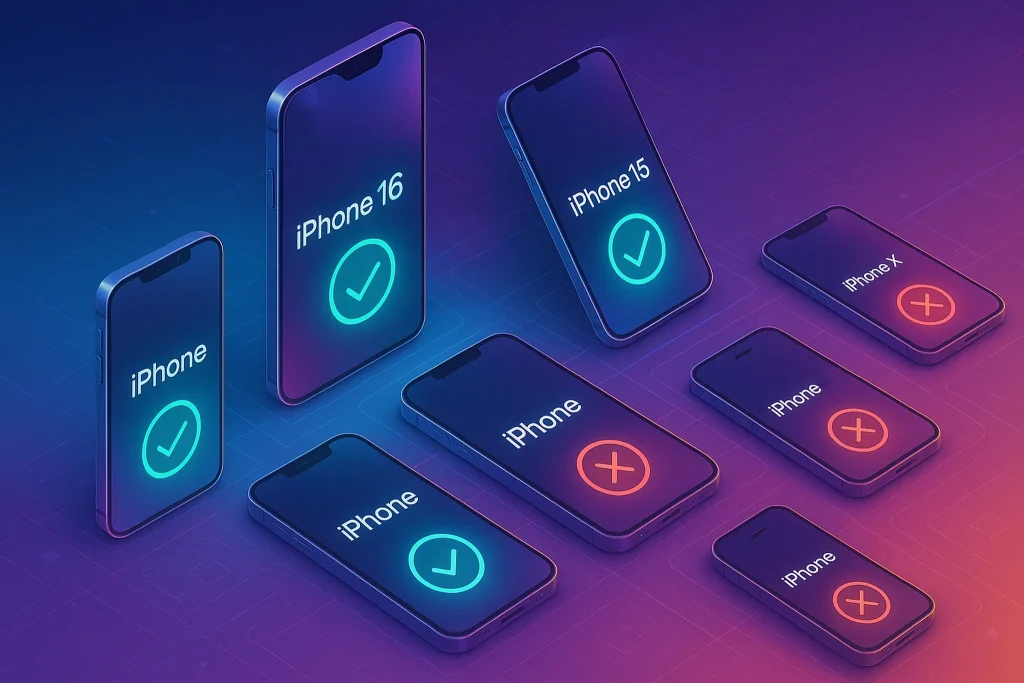-This post may contain affiliate links. If you click on one and make a purchase, I may earn a small commission at no extra cost to you.-
📡 Intro
While many regions are still catching up with full 5G deployment, the tech world is already buzzing about 6G. Is it hype or the real next step?
In this post, we’ll break down what 6G is expected to offer, how it compares to 5G, and why it’s not too early to start paying attention. From lightning-fast speeds to ultra-low latency, 6G could reshape how we live, work, and communicate.
Some of the underlying technologies enabling 6G—like edge AI and quantum-level data processing—are already making waves. For a deeper dive, check out our recent post on Quantum Computing Breakthroughs, which explores how quantum networks could complement 6G’s data infrastructure.
1. Where We Are Now: State of 5G in 2025
As of 2025, 5G is no longer a buzzword—it’s a reality in many developed countries. Nations like South Korea, the U.S., China, and several EU members have wide coverage, while others are rapidly expanding.
🌐 Global Status Update
-
South Korea leads with the most consistent 5G speeds and nationwide availability.
-
United States offers wide coverage, but users still report inconsistencies in mmWave support.
-
China has rolled out over 2 million 5G base stations, dominating urban infrastructure.
-
Europe is progressing, but cross-border harmonization of spectrum remains a challenge.
-
In developing countries, 5G is still limited to urban pilot zones or high-traffic corridors.
Despite progress, many consumers are disappointed, expecting instant “gigabit everywhere” performance. The reality is:
-
mmWave = high speed but very short range
-
Sub-6GHz = wider reach but similar to advanced 4G
-
Devices and infrastructure don’t always align (carrier aggregation issues)
This makes 5G a transitional technology—crucial, but not the endgame.
Key use cases of 5G today:
-
Home broadband replacement with Fixed Wireless Access (FWA)
-
Cloud gaming with smoother streaming and ultra-low latency
-
Autonomous vehicles that communicate in near real-time
-
Remote surgery where every millisecond matters
-
Industrial IoT with precision monitoring in factories
5G enables these with:
-
Speeds up to 10Gbps
-
Latency around 1ms
-
Massive device connectivity
Still, not all regions have 5G access, and the infrastructure is far from global saturation.
Also, don’t miss our overview of the AI Arms Race, where Big Tech firms are laying the groundwork for the intelligent networks that 6G demands.
2. What Is 6G? And When Will It Arrive?
6G isn’t here yet, but it’s not just a concept anymore. Research and standardization efforts are underway across the globe, with a projected rollout beginning around 2030.
THz: The New Frontier
The terahertz (THz) band—between microwave and infrared—offers untapped speed, but with significant challenges:
-
THz waves are extremely short-range, requiring ultra-dense infrastructure
-
Materials like graphene may replace traditional silicon in 6G transceivers
-
Atmospheric absorption makes long-distance THz transmission difficult
Global Research Push
Several flagship projects are leading the charge:
-
6G Flagship (Finland): Europe’s top academic initiative
-
Next G Alliance (US): Industry-led consortium backed by AT&T, Qualcomm, and Apple
-
IMT-2030 (China): Government-driven program for global 6G dominance
Most predictions align around 2030 for commercial rollout, with trials starting 2026–2027.
What’s expected:
-
Speeds reaching up to 1 Terabit per second (Tbps)
-
Latency potentially under 0.1 milliseconds
-
Utilization of terahertz (THz) spectrum, which requires entirely new antennas and materials
-
Deep integration with AI and sensing technology
-
Intelligent, context-aware connectivity that adapts on the fly
Key players like Samsung, Nokia, Ericsson, Huawei, and academic institutions are working on pilot tests and defining 6G standards.
📈 3. 5G vs. 6G – Side-by-Side Comparison
| Feature | 5G | 6G (Projected) |
|---|---|---|
| Speed | Up to 10Gbps | Up to 1Tbps |
| Latency | ~1ms | <0.1ms |
| Spectrum | Sub-6GHz, mmWave | Terahertz (THz) |
| Intelligence | Network-optimized | AI-integrated & device-aware |
| Energy Efficiency | Improved over 4G | Highly efficient via AI scheduling |
| Key Use Cases | IoT, gaming, streaming | Metaverse, holograms, edge robotics |
| Coverage | National rollout (in progress) | Urban-first, remote via satellite |
| Security | Strong encryption | Proactive, adaptive threat prevention |
6G is not just about speed—it’s about creating real-time, intelligent networks that support immersive technologies and autonomous systems.
4. Use-Case Layering: Who Will Actually Benefit?
While 6G might sound futuristic, it has very real implications for everyday users, businesses, and underserved regions.
For everyday users:
-
8K video streaming with zero buffering
-
Lag-free augmented reality (AR) experiences
-
Mixed reality in mobile devices, making the metaverse mainstream
-
Real-time translation via smart glasses during travel or meetings
-
Multi-sensory virtual concerts—feel the bass, see the visuals, move inside the show
-
Spatial computing in education, where students interact with 3D concepts in AR/VR
For businesses and industry:
-
Edge-based AI delivering real-time decisions on devices
-
Ultra-responsive robotics in manufacturing and logistics
-
Advanced telepresence for global collaboration
- Fully autonomous factories where machines respond to shifts in milliseconds
- Smart agriculture: drones analyze crops in real time and coordinate with robots on the ground
- Zero-lag cloud collaboration: imagine Figma or CAD tools as real-time shared 3D environments
For remote and underserved areas:
-
6G could leapfrog traditional fiber by offering ultra-fast wireless broadband without digging trenches or installing cables.
💡 Quick insight: If you’ve ever struggled with dropped calls or video lag in rural areas, 6G’s goal is to make that experience a thing of the past.
🎯 Want Update?
Want updates on 6G breakthroughs and emerging tech before the rest of the web?
Join our insider list for weekly dispatches from the frontlines of future tech.
🔒 We respect your privacy. No spam.
🛰️ 5. The Role of AI and Satellite in 6G
6G is more than just faster speeds—it represents a smart, adaptive ecosystem. Artificial intelligence won’t just manage network traffic, it’ll predict and optimize your experience in real time.
AI at the Core of the Network
Unlike 5G, where AI is mostly used for backend optimization, 6G integrates AI into the very architecture:
-
AI will allocate bandwidth dynamically depending on application urgency
-
It will predict usage patterns and preempt congestion before it happens
-
Security protocols will become proactive, adapting based on anomaly detection
Use-case example:
A city-wide emergency like an earthquake—6G AI instantly prioritizes first responders’ devices and reroutes all nonessential data traffic.
Satellite + Terrestrial Convergence
6G will blur the lines between terrestrial networks and satellite coverage. LEO constellations like:
-
Starlink (SpaceX)
-
OneWeb (UK)
-
Project Kuiper (Amazon)
will be key to delivering ultra-fast 6G even in rural Africa, deserts, oceans, or disaster-hit zones.
A combined AI + Satellite + Sensor system allows:
-
Autonomous shipping vessels to maintain instant contact
-
Remote energy facilities to operate with real-time diagnostics
-
Environmental tracking systems (like wildfires, water levels) to auto-report to cloud AI
6G = Always-on connectivity, everywhere.
Imagine a world where:
-
Your phone adjusts connection priorities based on what you’re doing
-
Smart glasses communicate with satellites for low-latency AR
-
Sensors across a city feed environmental data into AI systems for instant response
Satellite constellations—like those pioneered by SpaceX—are expected to play a major role in enabling global 6G coverage, especially in places where land-based infrastructure is limited.
🔮 6. Future Impacts and Challenges
As powerful as 6G sounds, it comes with significant hurdles.
Security Threats
-
AI-generated spoofing attacks could fool real-time systems unless countermeasures are embedded
-
Quantum computing might break traditional encryption—requiring post-quantum cryptography by default in 6G networks
-
Hyperconnectivity increases attack surface dramatically: every sensor, drone, or vehicle could be a target
Environmental & Energy Costs
The THz band demands dense infrastructure with high energy draw. Concerns include:
-
e-waste from frequent hardware upgrades
-
Data centers struggling to meet carbon neutrality goals
-
Satellites adding to space congestion if not regulated
Efforts toward Green 6G include:
-
Energy harvesting chips
-
AI-managed sleep states
-
Biodegradable micro-sensors
Legal and Regulatory Complexity
Governments must deal with:
-
Spectrum regulation across borders
-
Ethical guidelines for AI-driven networks
-
Data privacy laws when billions of sensors transmit data continuously
These require global cooperation—similar to climate treaties, but for telecoms.
Security
AI-driven networks could introduce new cybersecurity threats. If 5G made certain attacks harder, 6G could empower smarter threats unless secured properly.
Regulation
Governments will face a steep learning curve when it comes to regulating THz spectrum and defining privacy standards for AI-integrated networks.
Infrastructure
6G requires entirely new hardware, cooling systems, and spectrum management strategies. The transition won’t be seamless or cheap.
🌍 7. Global Race: Who’s Leading the 6G Charge?
Make no mistake—6G is not just a tech race, it’s a geopolitical battleground. Whoever leads 6G will control the next data economy.
🇨🇳 China
-
Announced first 6G test satellite in 2020
-
IMT-2030 group working on global standard dominance
-
Heavy government funding, close industry-academia collaboration
🇺🇸 United States
-
Next G Alliance includes Apple, Google, Qualcomm, AT&T
-
Focus on open standards and security-first frameworks
-
Strong push for international partnerships (EU, Japan)
🇪🇺 European Union
-
Hexa-X and 6G Flagship as part of Horizon Europe
-
Emphasis on privacy, ethics, and sustainability
-
Targeting leadership in both deployment and regulation
🇰🇷 South Korea
-
Samsung and LG lead in hardware R&D
-
Government-backed 6G pilot zones expected by 2028
-
Historical first-to-market advantage from 5G era continues
This is more than speeds—it’s about influence, innovation, and national resilience.
🧠 Nerd Verdict
6G isn’t just an upgrade—it’s a generational leap. We’re moving from fast connections to intelligent, context-aware networks that could redefine how we interact with the digital world.
But here’s the catch: it’s still years away. Despite the hype, 5G remains the dominant player in global connectivity—and will continue to be the backbone for most of this decade.
So, what should you do?
-
Embrace 5G’s real-world benefits now
-
Stay informed about 6G progress
-
Plan for the future without ignoring the present
The future is wireless. But today’s strategy starts with mastering the present.
Concerned about future cyber threats? Read our post on Cybersecurity in 2025 for insights on how to stay protected as networks evolve.
❓ FAQ: Nerds Ask, We Answer
💬 Would You Bite?
If someone gave you a 6G phone today—but it only worked in one smart city—would you use it?
And more importantly…
How do you imagine living in a world where everything is connected in real time?Let us know below! 👇



